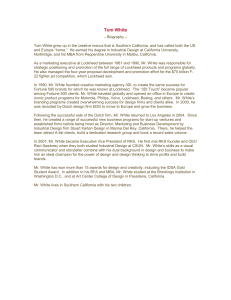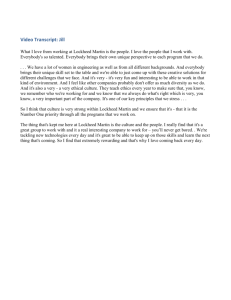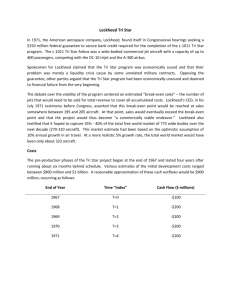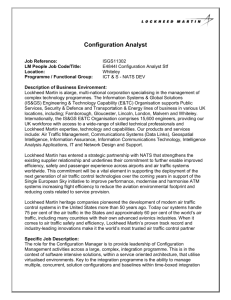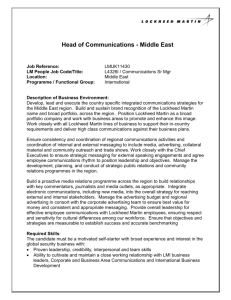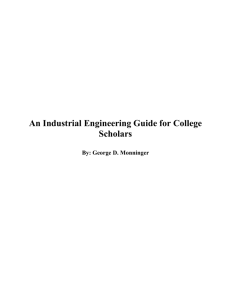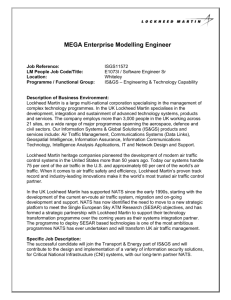Lockheed Tri Star Case Study - 640
advertisement
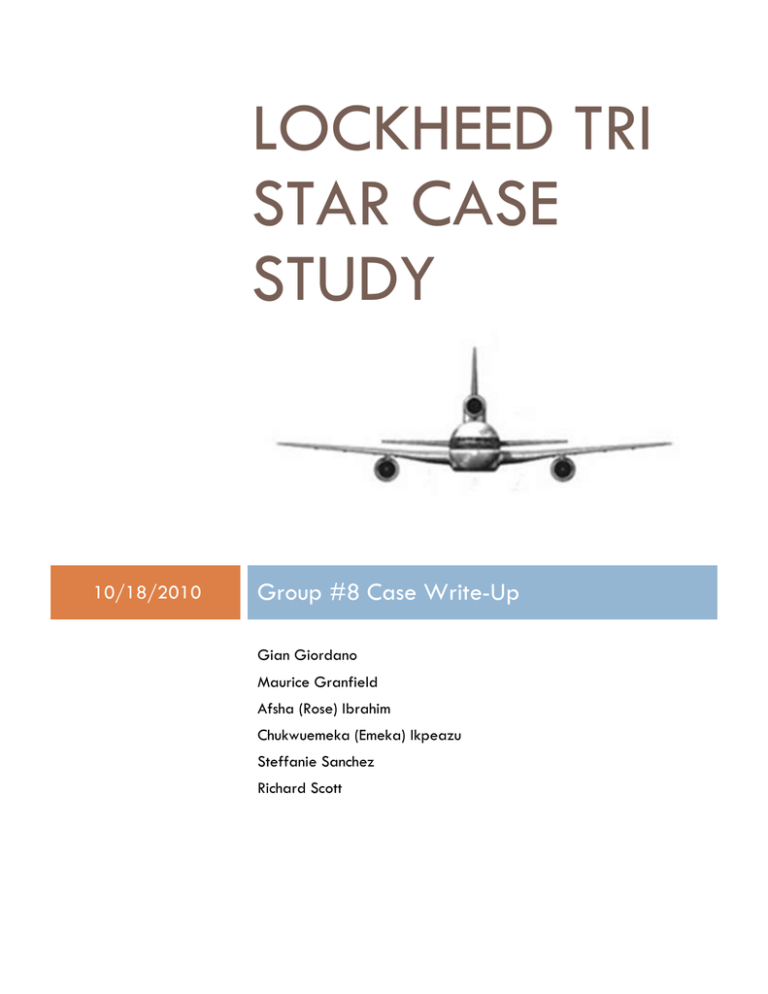
LOCKHEED TRI STAR CASE STUDY 10/18/2010 Group #8 Case Write-Up Gian Giordano Maurice Granfield Afsha (Rose) Ibrahim Chukwuemeka (Emeka) Ikpeazu Steffanie Sanchez Richard Scott Lockheed Tri Star Case Study Lockheed Tri Star Case Study EXECUTIVE SUMMARY Although highly regarded by the military, Lockheed sought to move into the lucrative civilian commercial aviation sector and compete with Boeing, McDonnell Douglas and Airbus. Lockheed began design and testing in 1966 on their entry, the “Tri Star”, which boasted a range of over 6,000 miles with nearly 400 passengers and speeds of close to 600 mph. They had already invested nearly $900 million in development costs. Carried by state of the art Rolls Royce turbofan engines, the L-1011 was by all accounts, a technological winner and might be the company’s ticket back to solvency. The summer of 1971 found the once formidable company on the brink of disaster. Despite the nearly a $1 billion in sunk costs, Lockheed was in need of $250 million more to bring the plane to market, but its bankers would not commit without federal loan guarantees. Spokespersons for Lockheed claimed before Congress that the Tri-Star program was economically sound and that their problem was mere liquidity crisis. However, opposition to the guarantee focused on estimated break-even sales – the number of jets that would need to be sold for total revenue to cover all accumulated costs. This case illustrates the importance of NPV analysis in capital budgeting. We examined the decision to invest in the Tri-Star project by forecasting the cash flow associated with the project for a volume of 210 planes. We also asked what a valid estimate of the NPV of the Tri-Star project at a volume of 210 planes as of 1967 would be. We found this to be -$584 M. This was clearly an unacceptable NPV for capital budgeting on the project. A break-even analysis revealed that the project reached economic break-even with the production of 275 planes at $12.5 M per unit but did not reach value break-even at that level of production. We found that to reach value break-even Tri-Star would have to produce about 400 planes at $11.75 M per unit. The NPV at this rate was $42 M. It is clear that the decision by Lockheed to embark on the Tri Star program was not a reasonable one. Lockheed’s share price plummeted from $64 (Jan 1967) to $11 (Jan 1971). It has lost $599 M worth of shares. This case drives home the importance of discounting and NPV, and shows the adverse effect of a negative NPV project on shareholder value. Page 1 Lockheed Tri Star Case Study INTRODUCTION A PLANE TOO BIG TO FAIL… In the aftermath of Wall Street’s collapse of 2008, we readily associate the now familiar debate over which businesses or industries are “too big to fail” with the recent events at Lehmann Brothers, Bear Stearns, AIG and General Motors—it is a concept with deep roots in the American political scene. Certainly, the numbers have changed by logarithmic proportions, with “billions’ replacing “millions’ as the units of concern. But for tax payers in the summer of 1971, the case was made before the public with open Congressional hearings that without help, Lockheed Aircraft Corporation would be on the verge of failure- and with it would disappear over 60,000 jobs and one of the nation’s most strategic defense contractors. Although highly regarded by the military, Lockheed sought to move into the lucrative civilian commercial aviation sector and compete with Boeing, McDonnell Douglas and Airbus. Each planned offerings in the wide bodied, long distance sector with the 747, DC-10 and A-300 all on the drawing board for introduction between 1969 and 1972. Lockheed began design and testing in 1966 on their entry, the “Tri Star”, which boasted a range of over 6,000 miles with nearly 400 passengers and speeds of close to 600 mph. They had already invested nearly $900 million in development costs. Carried by state of the art Rolls Royce turbofan engines, the L-1011 was by all accounts, a technological winner and might be the company’s ticket back to solvency. The summer of 1971 The once formidable company found itself on the brink of disaster. Despite the nearly $1 billion in sunk costs, Lockheed was in need of $250 million more to bring the plane to market, but its bankers would not commit without federal loan guarantees. Adding to their concern were cost over runs in other projects, and the failure at their engine supplier, Rolls Royce, which had required a government takeover. Orders for DC 10’s were already being filled while Lockheed desperately sought to shore up its supply chain and begin production. Looking back, it’s hard to imagine a half generation ago that this issue filled the front pages of newspapers and periodicals. Just last year, “Cash for Clunkers”, which subsidized the destruction of used automobiles, cost some $3 billion, or 12 times the loan guarantee requested. It was a familiar debate four decades ago, as politicians argued that it was not the role of government to insulate businesses from the pressures of the free market. And even a young Alan Greenspan warned that “if the administration made private credit available to one privileged firm, the supply of credit available for all will be reduced”1 In this case study, we will review the decision reached by our elected leaders based on the testimony given to their committee by Lockheed’s Chairman Haughton—that his company would reach a “break even” position after approximately 275 planes, and expected growing profits in future years based on their hopes to capture a 40% market share. We will examine whether the shareholders were well served, and with the luxury of time gone by, the accuracy of those sales projections. But how would that “accounting break even” number of 275 planes hold up once the time value of money was considered and future inflows were appropriately discounted? Did the bankers know something Congress has yet to learn? Was it that time is money? Page 2 Lockheed Tri Star Case Study DATA ANALYSIS & RESULTS LOCKHEED TRI STAR & CAPITAL BUDGETING We start by laying out data per the details known from the Lockheed Tri Star business case. Based on stated assumptions, we present an analysis as it relates to the decision of supporting the Tri Star program. Please see Appendix A for complete data analysis methods and calculations. Value-Added Considerations: 1. At planned (210) units, what was the true value of the Tri Star program? 2. At a “break-even” production of roughly 300 units, did Lockheed really break even in value terms? 3. At what sales volume did the Tri Star program reach true economic (as opposed to accounting) break-even? 4. Was the decision to pursue the Tri Star program a reasonable one? What were the effects of this “project” on Lockheed shareholders? Lockheed estimated a break-even sales point of somewhere between 195 and 205 aircraft. At the point this estimate was given, only 103 firm orders were taken plus 75 options-to-buy (essentially 178 aircrafts in demand). The company failed to perform basic net present value calculations that would have provided a realistic proposal of costs and cash flows which may have resulted in termination of the project due to lack of real value. Page 3 Lockheed Tri Star Case Study The method used to calculate net present value was based on five estimated break-even sales figures provided by the sources highlighted below (refer to Exhibit 1). Using Excel, pre-production cash flows were estimated at $900 million from the end of 1967-1971. Negative cash outflows based on estimated unit production costs were calculated followed by revenues starting in 1972 with each plane priced at $16 million in all scenarios. From the end of 1971-1977, Lockheed planned to produce 210 Tri Star planes at an average unit production cost of $14 million per aircraft with 35 planes per year. Deposits equaling roughly 25% of the price of each aircraft were received two years previous to delivery date. At a 10% discount rate, the net present value of future cash flows would be negative $584 million. Exhibit 1 Source Lockheed Lockheed Industry Analysts Actual Break-Even Lucrative Project Scenario Est. Production Units 210 275 300 402 500 Est. Cost Per Unit (in mill.) $14 $12.50 $12.50 $11.75 $11 NPV(10%) ($584) ($311) ($274) $47 $436 Despite industry analysts predicting 300 units as Lockheed’s break-even sales point, at this level, net present value remained insufficient to cover costs at negative $274 million. At 275 planes costing $3.5 million each, the company achieved accounting breakeven at $962.5 million profit vs. $960 million in development costs. If the company had performed a true value break-even analysis, management would have realized that roughly 400 Tri Star aircraft (about 67 per year for six years) costing somewhere between $11.75 million and $12 million per unit would have to be sold in order to break even. Based on the “learning curve” effect, production costs at levels above 300 would average lower than $14 million per unit. The assumptions for per unit costs are shown in the following chart: Exhibit 2 Given that the Tri Star project was riskier than the typical Lockheed operation, the appropriate discount rate would probably be higher than 10%. At an estimated 15% discount rate (refer to Exhibit 3), break-even sales would have occurred once the company sold 420 planes (70 per year for six years) costing $11.75 million per unit. Under a worst-case scenario at a 20% cost of capital, the firm would need to produce 636 aircraft at the same per unit cost (106 per year for six years). Considering this information, it is hardly shocking that the company’s share price dropped 96% from 1967 to 1974 and that the project destroyed shareholder value. Page 4 Lockheed Tri Star Case Study Exhibit 3 Shareholder Value The decision to pursue the Tri Star program was unreasonable and overly ambitious. If the proper analysis was completed, this project may have been terminated and the company could have invested its capital in a profitable investment that would have increased shareholder wealth. Instead, the decision resulted in Lockheed’s share price plummeting from $64 (Jan 1967) to $11 (Jan 1971). CONCLUSION A LOSS TOO BIG TO IGNORE… Joining the list of Lehmann Brothers, Bear Stearns and others, the Lockheed Tri Star was an unfortunate case of a loss so big, it made history. Their initial estimates to break-even proved to be extremely optimistic. Based on the cost data presented, it is apparent the shareholders were poorly served, as investors evidently more properly valued the project in the free market. Indeed, the reliance on a “break even” analysis presupposed that the company proceeded with development and program costs with no expectation of a positive return, much less any recovery of their interest expenses on capital borrowed to advance the program. Given flawed decision-making, “Lockheed lost $2.5 billion on the TriStar project and the experience buried them in commercial aerospace. In December 1981, Lockheed announced they were stopping production and taking a final $400 million write off to cover the costs. They never made another major airliner.”2 Page 5 Lockheed Tri Star Case Study APPENDIX A Page 6 Lockheed Tri Star Case Study Page 7 Lockheed Tri Star Case Study APPENDIX B RAINBOW PRODUCTS [A] Payback = 7 years; NPV = -945.68; IRR = 11.5%. Rainbow should not purchase it due to a negative NPV and an IRR that is < Cost of Capital. [B] PV of Perpetuity = C/r; PV = 4500/.12 = 37500; NPV = Investment + PV = -35000 + 37500 = 2500. Rainbow should purchase with service contract due to a positive NPV. [C] PV of growing perpetuity = C1/r-g = $4,000/0.12 - 0.04 = $4,000/0.08 = $50,000; NPV = Co + PV = -$35,000 + $50,000 = $15,000. Therefore, Rainbow Products should accept the option to enhance the capability of the machine over time. This option is even better than the option of purchasing the machine with service contract. HOT DOG CONCESSION STAND [A] Given highest IRR = 1207.6%, the option to rent a larger stand is best. [B] Given highest NPV = $34,825.76, the option to build a new stand is best. [C] MBA TECH Page 8 Lockheed Tri Star Case Study VALUE ADDED INDUSTRIES [A] NPV = $100,000 [B] [C] Page 9 Lockheed Tri Star Case Study REFERENCES 1. [intro source] 2. [others] Page 10
